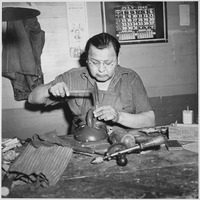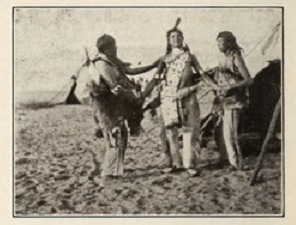Jesse Cornplanter facts for kids
Quick facts for kids
Jesse Cornplanter
|
|
|---|---|

Jesse Cornplanter making a ceremonial mask, Tonawanda Community House, Tonawanda, New York. Photographed in 1940.
|
|
| Born | Hayonhwonhish September 16, 1889 Cattaraugus Reservation, NY |
| Died | March 18, 1957 (aged 67) Genesee, NY |
| Occupation | Actor, Author, Artist, Craftsman, Keeper of Seneca Culture |
| Citizenship | American |
| Subject | Seneca life, culture, and religion |
| Literary movement | Iroquois Realism |
| Notable works | Legends of the Longhouse, Iroquois Indian Games and Dances, collection SC12845 at the New York State Library, illustrated The Code of Handsome Lake |
| Relatives | Father Edward Cornplanter (Seneca name Sosondowah) Mother Nancy Jack |
Jesse J. Cornplanter (born September 16, 1889 – died March 18, 1957) was a talented Native American man. He was an actor, artist, author, and craftsman. He was also a Seneca Faithkeeper, which means he helped keep his people's traditions alive. He was a veteran of World War I and received an award for his service.
Jesse Cornplanter was the last male descendant of Cornplanter. This Cornplanter was an important Haudenosaunee leader and war chief in the 1700s. Jesse's Seneca name was Hayonhwonhish, meaning "He Strokes the Rushes."
Jesse Cornplanter illustrated many books about Seneca and Iroquois life. He also wrote and illustrated his own book, Legends of the Longhouse, in 1938. This book shares many traditional Iroquois stories. He was also the first Native American to play a main role in a movie. This silent film was called Hiawatha and came out in 1913.
Contents
About Jesse Cornplanter
Jesse Cornplanter was born in 1889 on the Cattaraugus Reservation in New York. His parents were Nancy Jack and Edward Cornplanter, both Seneca. His mother belonged to the Snipe Clan. In their tradition, children inherited their clan from their mother.
Jesse had six sisters and three brothers. Sadly, many of them passed away from childhood diseases. Only two of his sisters, Carrie and Anna, lived to adulthood. Carrie later passed away in 1918. Jesse was the last direct male descendant of the famous Seneca war chief, Cornplanter.
Jesse only went to school until the third grade. However, he knew a lot about Seneca customs, songs, and ceremonies. This made him a very important person for learning about Seneca culture. People from inside and outside his tribe often asked him for information.
Military Service and Family Life
During World War I, Jesse Cornplanter joined the U.S. Army in 1917. He served in Europe and was honorably discharged in 1919. He was injured during the war and received the Purple Heart medal.
While he was serving, his father passed away. After he returned, many more family members passed away during the 1918 flu pandemic. This included his mother Nancy and his sister Carrie. Only his sister Anna and two of Carrie's children survived. Jesse helped care for these children when he came home.
After the war, Jesse Cornplanter held many respected roles in his tribe. He was a ceremonial chief of the Long House. He was also the chief of New Town, a traditional village. He sang for the Great Feather Dance and was the main singer for many ceremonies.
Jesse Cornplanter was married to Elsina Billy. Her Seneca name was Yoweh'sonh. She was from the Beaver Clan of the Tonawanda.
Jesse Cornplanter did not have any children. When he passed away in 1957, a special treaty ended. This treaty had given Cornplanter's family a piece of land in Pennsylvania forever. This land was called the Cornplanter Tract.
Much of this land was later covered by water when the Kinzua Dam was built in 1965. The dam created the Allegheny Reservoir. The U.S. Army Corps of Engineers built the dam to control floods and make electricity. They also took about 10,000 acres of land from the Seneca Nation for the dam.
Jesse Cornplanter as an Actor
In 1906, Jesse Cornplanter traveled with his father, Edward. They performed and sang in a show called the Hiawatha pageant. They traveled for many months, even going to England and other parts of Europe. People really liked his performances.
He also played the main character, Hiawatha, in a silent film. This movie, Hiawatha, was released in 1913. It is believed to be one of the first movies to have Native Americans in the cast. People thought it was much better than other Hollywood movies that showed Native Americans at the time. A movie magazine called Moving Picture News said Jesse Cornplanter was "a real matinee idol."
Jesse Cornplanter's Artwork
Jesse Cornplanter started to gain recognition for his art when he was just a teenager. He never had formal art lessons, but he became a very successful artist. He was skilled at showing scenes from his tribe's life.
Arthur C. Parker, who was also Seneca, later became the Director of the Rochester Museum and Science Center. When Jesse was young, Parker asked him to draw scenes of everyday Seneca life. This started an eight-year teamwork between them, beginning in 1901. Today, 46 of Jesse Cornplanter's drawings are kept at the New York State Library.
Another person, Frederick Starr, asked Jesse Cornplanter to illustrate a book. This book was called Iroquois Indian Games and Dances (around 1903). It showed drawings of Iroquois rituals, dances, and games. Jesse was only 12 years old when he worked on this book. The book's cover even gave him credit as "Jesse Cornplanter, Seneca Indian Boy." Starr chose Jesse because he saw how talented the young artist was. He noted Jesse's "firmness of line, boldness, and good skill in grouping" in his drawings.
The money made from selling Jesse's illustrations was used for a special award. This award was called the Cornplanter Medal. It was given out every two years to someone who helped research and share knowledge about the Iroquois people.
Jesse Cornplanter also illustrated The Code of Handsome Lake. This was a manuscript that his father, Edward Cornplanter, worked on with Arthur C. Parker.
In 1938, Jesse Cornplanter wrote and illustrated his own book, Legends of the Longhouse.
His paintings are known for being in the Iroquois Realist Style. This art style began in the 1820s with the work of brothers David and Dennis Cusick, who were Tuscarora.
Even though he is best known for his drawings, Jesse Cornplanter was also a traditional wood carver. He had a big influence on many Haudenosaunee artists who came after him.
See also
 In Spanish: Jesse Cornplanter para niños
In Spanish: Jesse Cornplanter para niños


